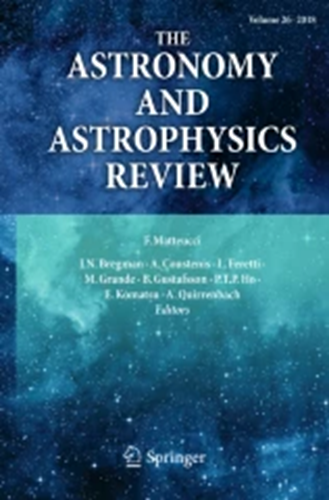寻找Sgr V4743闪烁的1mhz变异性:一个以高速率增加的灾难性变量
IF 27.8
1区 物理与天体物理
Q1 ASTRONOMY & ASTROPHYSICS
引用次数: 1
摘要
目的:一些被充分研究的突变变量(cv)显示出快速变化的离散特征频率;最突出的是log(f/Hz) $\simeq$ -3。因为我们仍然只有少量的统计数据,所以我们获得了一个新的观察结果来测试这是否是CVs的一般特征,特别是如果质量传递以矮新星爆发时典型的高速率发生,即所谓的“高状态”。方法:我们分析了静止新星和中极V4743 Sgr的光学开普勒数据。这个系统的宿主是一颗白矮星,它通过一个处于高状态的圆盘吸积。我们计算了功率密度谱,并搜索了中断或特征频率。我们的目标是评估闪烁的兆赫频率是否为一般特征。结果:V4743 Sgr的断裂频率为log(f/Hz) $\simeq$ -3。这种检测增加了mHz特征频率是高状态下CVs的一般特征的可能性,从69% to 91%. Furthermore, we propose the possibility that the variability is generated by similar mechanism as in the nova-like system MV Lyr, which would make V4743 Sgr unique.本文章由计算机程序翻译,如有差异,请以英文原文为准。
Searching for the 1 mHz variability in the flickering of V4743 Sgr: A cataclysmic variable accreting at a high rate
AIMS: A few well studied cataclysmic variables (CVs) have shown discrete characteristic frequencies of fast variability; the most prominent ones are around log(f/Hz) $\simeq$ -3. Because we still have only small number statistics, we obtained a new observation to test whether this is a general characteristic of CVs, especially if mass transfer occurs at a high rate typical for dwarf nova in outbursts, in the so called "high state". METHODS: We analyzed optical Kepler data of the quiescent nova and intermediate polar V4743 Sgr. This system hosts a white dwarf accreting through a disk in the high state. We calculated the power density spectra, and searched for break or characteristic frequencies. Our goal is to assess whether the mHz frequency of the flickering is a general characteristic. RESULTS: V4743 Sgr has a clear break frequency at log(f/Hz) $\simeq$ -3. This detection increases the probability that the mHz characteristic frequency is a general feature of CVs in the high state, from 69% to 91%. Furthermore, we propose the possibility that the variability is generated by similar mechanism as in the nova-like system MV Lyr, which would make V4743 Sgr unique.
求助全文
通过发布文献求助,成功后即可免费获取论文全文。
去求助
来源期刊

The Astronomy and Astrophysics Review
地学天文-天文与天体物理
CiteScore
45.00
自引率
0.80%
发文量
7
期刊介绍:
The Astronomy and Astrophysics Review is a journal that covers all areas of astronomy and astrophysics. It includes subjects related to other fields such as laboratory or particle physics, cosmic ray physics, studies in the solar system, astrobiology, instrumentation, and computational and statistical methods with specific astronomical applications. The frequency of review articles depends on the level of activity in different areas. The journal focuses on publishing review articles that are scientifically rigorous and easily comprehensible. These articles serve as a valuable resource for scientists, students, researchers, and lecturers who want to explore new or unfamiliar fields. The journal is abstracted and indexed in various databases including the Astrophysics Data System (ADS), BFI List, CNKI, CNPIEC, Current Contents/Physical, Chemical and Earth Sciences, Dimensions, EBSCO Academic Search, EI Compendex, Japanese Science and Technology, and more.
 求助内容:
求助内容: 应助结果提醒方式:
应助结果提醒方式:


